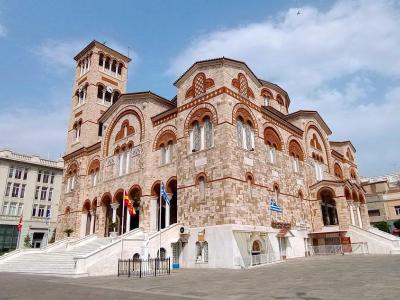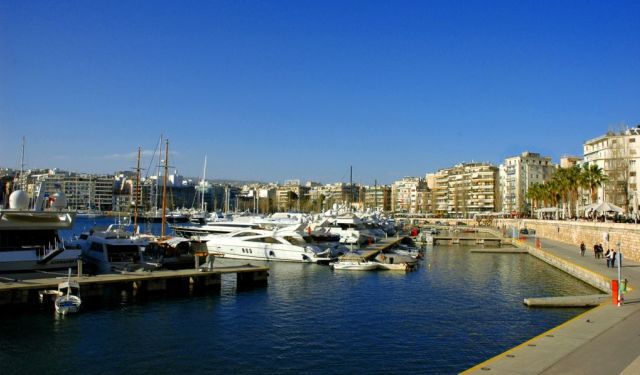
Hagia Triada (Holy Trinity Cathedral), Piraeus (must see)
The Holy Trinity Cathedral is one of the most striking Greek Orthodox churches in the city. Serving as the cathedral and metropolitan seat of the Holy Metropolis of Piraeus, it is both a religious and architectural landmark. The original church was built in 1839, just after Greece gained independence from the Ottoman Empire, and was completed by 1845.
However, during World War II, the cathedral was completely destroyed in the Allied bombing of Piraeus on January 11, 1944, tragically taking the lives of people who had sought refuge within. In the same year, a makeshift church was erected to continue serving the parish, standing for twelve years until the construction of the new cathedral began. The current structure, built in Byzantine style, was completed in 1979, featuring intricate mosaics, domes, and religious iconography that make it a must-visit attraction.
The Holy Trinity Cathedral is an architectural masterpiece, covering 835 square meters and accommodating 3,100 people. It is a three-aisled basilica, with the central aisle dedicated to the Holy Trinity, the right aisle to the Apostles Peter and Paul, and the left aisle to Saint Skepi. Additionally, two chapels—one dedicated to Saint Nectarius and another to Saints Cyril and Methodius—are incorporated into the structure. Notably, a section of the ancient Long Walls of Athens is housed within the chapel of Saints Cyril and Methodius, adding historical depth to the cathedral.
Its imposing dome, supported by eight large arches, contains 40 windows that illuminate the interior, ensuring the Christ Pantocrator painting is visible from every corner of the church. The cathedral's gold-adorned murals, inspired by both the Macedonian and Cretan Schools of Byzantine art, were initially painted by Stephanos Almaliotis and later continued by his student, Anargyros Liakos.
The exterior of the cathedral is just as remarkable, with forged brass doors and an ornate marble iconostasis crafted by the Doukas brothers. The wood-carved iconostasis doors, made by Theophilos Nomikos, add to the intricate detailing. Outside, in the church’s courtyard, stands a statue of Constantine XI Palaiologos, the last emperor of the Byzantine Empire, symbolizing the deep connection between Greek Orthodox faith and Byzantine heritage.
However, during World War II, the cathedral was completely destroyed in the Allied bombing of Piraeus on January 11, 1944, tragically taking the lives of people who had sought refuge within. In the same year, a makeshift church was erected to continue serving the parish, standing for twelve years until the construction of the new cathedral began. The current structure, built in Byzantine style, was completed in 1979, featuring intricate mosaics, domes, and religious iconography that make it a must-visit attraction.
The Holy Trinity Cathedral is an architectural masterpiece, covering 835 square meters and accommodating 3,100 people. It is a three-aisled basilica, with the central aisle dedicated to the Holy Trinity, the right aisle to the Apostles Peter and Paul, and the left aisle to Saint Skepi. Additionally, two chapels—one dedicated to Saint Nectarius and another to Saints Cyril and Methodius—are incorporated into the structure. Notably, a section of the ancient Long Walls of Athens is housed within the chapel of Saints Cyril and Methodius, adding historical depth to the cathedral.
Its imposing dome, supported by eight large arches, contains 40 windows that illuminate the interior, ensuring the Christ Pantocrator painting is visible from every corner of the church. The cathedral's gold-adorned murals, inspired by both the Macedonian and Cretan Schools of Byzantine art, were initially painted by Stephanos Almaliotis and later continued by his student, Anargyros Liakos.
The exterior of the cathedral is just as remarkable, with forged brass doors and an ornate marble iconostasis crafted by the Doukas brothers. The wood-carved iconostasis doors, made by Theophilos Nomikos, add to the intricate detailing. Outside, in the church’s courtyard, stands a statue of Constantine XI Palaiologos, the last emperor of the Byzantine Empire, symbolizing the deep connection between Greek Orthodox faith and Byzantine heritage.
Hagia Triada (Holy Trinity Cathedral) on Map






Sight Name: Hagia Triada (Holy Trinity Cathedral)
Sight Location: Piraeus, Greece (See walking tours in Piraeus)
Sight Type: Religious
Sight Location: Piraeus, Greece (See walking tours in Piraeus)
Sight Type: Religious
Walking Tours in Piraeus, Greece
Create Your Own Walk in Piraeus
Creating your own self-guided walk in Piraeus is easy and fun. Choose the city attractions that you want to see and a walk route map will be created just for you. You can even set your hotel as the start point of the walk.
Piraeus Introduction Walking Tour
For many, Piraeus is the busy port from which you catch a ferry to a Greek island. But ask a local and you'll hear a different story. As Greece’s largest port and a crucial link between Athens and the Aegean, Piraeus has been a center of maritime activity for centuries. Its name is believed to come from the ancient Greek word, possibly meaning “the place over the passage” or... view more
Tour Duration: 2 Hour(s)
Travel Distance: 3.5 Km or 2.2 Miles
Tour Duration: 2 Hour(s)
Travel Distance: 3.5 Km or 2.2 Miles

